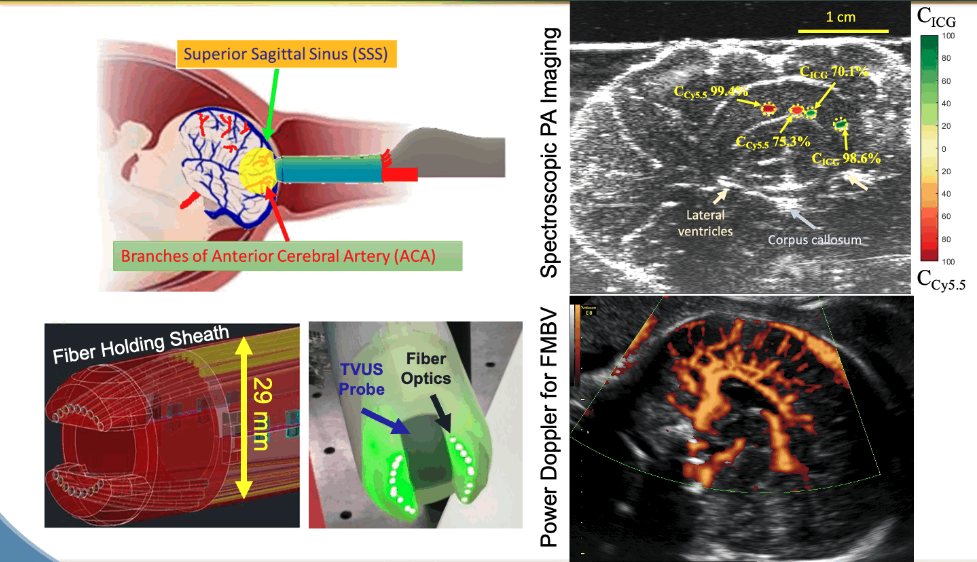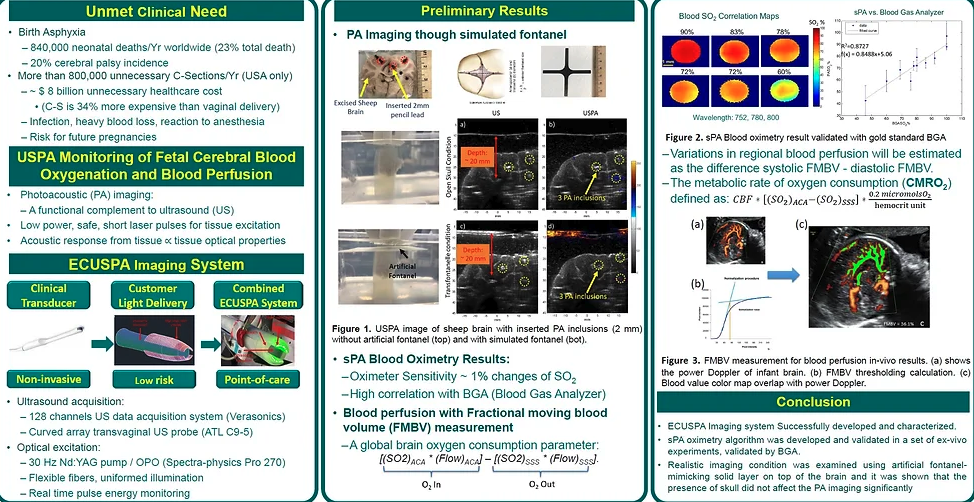Research


Summary:
-
The uterine cervix plays a central role in the maintenance of pregnancy and the process of parturition. Untimely cervical ripening may lead to cervical insufficiency, responsible for recurrent spontaneous abortion and preterm birth (PTB), the leading cause of infant death below the age of five.
-
This project aims to design and develop an integrated multi-parametric acoustic imaging system and method that can non-invasively quantify cervical remodeling and explore biological and physiological knowledge of it.
-
A prototype was developed by integrating B-mode Ultrasound (US), Viscoelastography (VE), and spectroscopic Photoacoustic (sPA) imaging modalities around a clinical transvaginal ultrasound (TVUS) probe. Ex-vivo and in-vivo studies showed the developed system had the potential to identify and quantify cervical remodeling, thus estimating the risk of PTB.
References:
-
Yan, Yan, et al. "Photoacoustic imaging of the uterine cervix to assess collagen and water content changes in murine pregnancy." Biomedical optics express 10.9 (2019): 4643-4655.
-
Yan, Yan, et al. "Spectroscopic photoacoustic imaging of cervical tissue composition in excised human samples." Plos one 16.3 (2021): e0247385.
-
Yan, Yan, et al. "A longitudinal study of cervical tissue composition changes during normal pregnancy in mice using spectroscopic photoacoustic." Biomedical Spectroscopy, Microscopy, and Imaging II. Vol. 12144. SPIE, 2022.
-
Mehrmohammadi, Mohammad, et al. "Ultrasound, photoacoustic, and viscoelastic imaging systems and methods for cervical analysis to assess the risk of preterm delivery." U.S. Patent Application No. 16/659,720.

Summary:
-
The uterine cervix plays a central role in the maintenance of pregnancy and the process of parturition. Untimely cervical ripening may lead to cervical insufficiency, responsible for recurrent spontaneous abortion and preterm birth (PTB), the leading cause of infant death below the age of five.
-
This project aims to design and develop an integrated multi-parametric acoustic imaging system and method that can non-invasively quantify cervical remodeling and explore biological and physiological knowledge of it.
-
A prototype was developed by integrating B-mode Ultrasound (US), Viscoelastography (VE), and spectroscopic Photoacoustic (sPA) imaging modalities around a clinical transvaginal ultrasound (TVUS) probe. Ex-vivo and in-vivo studies showed the developed system had the potential to identify and quantify cervical remodeling, thus estimating the risk of PTB.
References:
-
Yan, Yan, et al. "Photoacoustic imaging of the uterine cervix to assess collagen and water content changes in murine pregnancy." Biomedical optics express 10.9 (2019): 4643-4655.
-
Yan, Yan, et al. "Spectroscopic photoacoustic imaging of cervical tissue composition in excised human samples." Plos one 16.3 (2021): e0247385.
-
Yan, Yan, et al. "A longitudinal study of cervical tissue composition changes during normal pregnancy in mice using spectroscopic photoacoustic." Biomedical Spectroscopy, Microscopy, and Imaging II. Vol. 12144. SPIE, 2022.
-
Mehrmohammadi, Mohammad, et al. "Ultrasound, photoacoustic, and viscoelastic imaging systems and methods for cervical analysis to assess the risk of preterm delivery." U.S. Patent Application No. 16/659,720.
Model-based Optical and Acoustic Compensation for Quantitative Photoacoustic Tomography


Summary:
Breast cancer is among women's most diagnosed cancers in the United States – second to basal and squamous cell skin cancers. With women have nearly a 12.8% lifetime risk of developing breast cancer.
Existing imaging modalities, such as mammography, have lowered sensitivity in women with dense breasts (BI-RADS 3 and 4). Therefore, adjunct modalities such as ultrasound tomography (UST) are being studied.
Photoacoustic tomography (UST) can be a complement to UST and provides functional and molecular information to UST's structural information. Quantitative information such as oxygen saturation (one metric to identify cancer) from PAT suffers from increased bias and error due to optical attenuation from tissue.
To correct these effects, we synergistically combine structural information from UST to build a numerical model of the object of interest and estimate the light fluence using Monte Carlo light modeling. Sound speed and light fluence estimates make it possible to produce optical and acoustical compensated PAT OAcPAT. This OAcPAT algorithm has been shown to improve image quality and spectral unmixing measurements.
Reference: 1. Pattyn, A., Mumm, Z., Alijabbari, N., Duric, N., Anastasio, M. A., & Mehrmohammadi, M. (2021). Model-based optical and acoustical compensation for photoacoustic tomography of heterogeneous mediums. Photoacoustics, 23, 100275. 2. Pattyn, Alexander, et al. "Mild-Hyperthermia Generation and Control with a Ring-based Ultrasound Tomography." 2021 IEEE International Ultrasonics Symposium (IUS). IEEE, 2021. 3. Alshahrani, Suhail Salem, et al. "All-reflective ring illumination system for photoacoustic tomography." Journal of biomedical optics 24.4 (2019): 046004. 4. Avrutsky, Ivan, and Mohammad Mehrmohammadi. "Omnidirectional photoacoustic tomography system." U.S. Patent Application No. 16/634,634. Alshahrani, Suhail, et al. "The Effectiveness of the omnidirectional illumination in full-ring photoacoustic tomography." 2018 IEEE International Ultrasonics Symposium (IUS). IEEE, 2018.


-
Laser ablation procedures serve various applications ranging from fetal-based maladies to cancer therapies.
-
Imaging artifacts in US imaging, high costs, limited intra-operative guidance in magnetic resonance, and motion artifacts in X-ray imaging limit the catheter position detectability, hindering the safety of image-guided interventions.
-
Lack of real-time temperature monitoring induces additional complications, limiting the effectiveness of therapeutic doses delivered to the patient.
-
PA imaging complements a hybrid touch to US imaging, revealing optical properties of the target tissue. Together with US imaging visualizing the anatomical structures, PA imaging enhances image-guidance techniques by providing the real-time location of the catheter tip and tissue thermometry
References:
-
S. John, V. Yan, L. Kabbani, N. A. Kennedy, and M. Mehrmohammadi, "Integration of Endovenous Laser Ablation and Photoacoustic Imaging Systems for Enhanced Treatment of Venous Insufficiency," in 2018 IEEE International Ultrasonics Symposium (IUS), 2018, pp. 1-4: IEEE.
-
S. John, Y. Yan, S. Y. Forta, L. Kabbani, and M. Mehrmohammadi, "Integrated ultrasound and photoacoustic imaging for effective endovenous laser ablation: a characterization study," in 2019 IEEE International Ultrasonics Symposium (IUS), 2019, pp. 122-125: IEEE.
-
S. John, Y. Yan, L. Kabbani, N. A. Kennedy, and M. Mehrmohammadi, "Integration of endovenous laser ablation and photoacoustic imaging systems for enhanced treatment of venous insufficiency," in 2018 IEEE International Ultrasonics Symposium (IUS), 2018, pp. 1-4: IEEE.
-
S. John, Y. Yan, T. Shaik, L. Kabbani, and M. Mehrmohammadi, "Photoacoustic guided endovenous laser ablation: Calibration and in vivo canine studies," in 2020 IEEE International Ultrasonics Symposium (IUS), 2020, pp. 1-4: IEEE.
-
Y. Yan, S. John, M. Ghalehnovi, L. Kabbani, N. A. Kennedy, and M. Mehrmohammadi, "Ultrasound and photoacoustic imaging for enhanced image-guided endovenous laser ablation procedures," in Medical Imaging 2018: Ultrasonic Imaging and Tomography, 2018, vol. 10580, p. 105800T: International Society for Optics and Photonics.
-
Y. Yan, S. John, M. Ghalehnovi, L. Kabbani, N. A. Kennedy, and M. Mehrmohammadi, "photoacoustic Imaging for Image-guided endovenous Laser Ablation procedures," Scientific reports, vol. 9, no. 1, pp. 1-10, 2019.
-
Y. Yan, S. John, J. Meiliute, L. Kabbani, and M. J. U. i. Mehrmohammadi, "Efficacy of High Temporal Frequency Photoacoustic Guidance of Laser Ablation Procedures," vol. 43, no. 3, pp. 149-156, 2021.
-
Y. Yan et al., "Photoacoustic-guided endovenous laser ablation: Characterization and in vivo canine study," vol. 24, p. 100298, 2021.


Summary:
- Many clinical procedures utilize ablation to target abnormal tissues. For instance, pulmonary vein isolation is a procedure that uses radiofrequency ablation (RFA) to treat atrial fibrillation. Renal denervation uses RFA to burn the nerves in the renal arteries to treat resistant hypertension. Many cancers are also treated with RFA, such as hepatocellular carcinoma.
-
One problem with procedures using RFA is they lack the ability to monitor lesion formation and provide functional information in real-time.
-
The theranostic endoscopic system combines three medical modalities into one device. By utilizing ultrasound imaging, photoacoustic imaging, and laser-based ablation, the device can ablate tissue and simultaneously monitor lesion formation, temperature, and distinguish tissue types.
References:
-
M. Basij, S. John, D. Bustamante, L. Kabbani, W. Maskoun, and M. Mehrmohammadi, "Integrated Ultrasound and Photoacoustic-guided Laser Ablation Theranostic Endoscopic System," IEEE Transactions on Biomedical Engineering, 2022.
-
M. Basij, S. John, D. Bustamante, L. Kabbani, and M. Mehrmohammadi, "Development of an Integrated Photoacoustic-Guided Laser Ablation Intracardiac Theranostic System," in 2021 IEEE International Ultrasonics Symposium (IUS), 2021: IEEE, pp. 1-4.
-
M. B. Mohammad Mehrmohammadi, Samuel John, "Endoscopic array-based photoacoustic-guided laser ablation Theranostic System," Disclosure filed in August 2021.


Summary:
-
Preterm birth (PTB) is the leading cause of neonatal morbidity and mortality. It occurs in 5-18% of births, with approximately 15,000,000 PTBs per year.
-
Currently, predicting PTB is based on identifying a short cervix via transvaginal ultrasound. Unfortunately, this methodology has a sensitivity of ≤50%. Many image-based methodologies have been reported, but they do not consistently perform as well as cervical length.
-
The machine learning approach used in this project focuses on extracting important morphological features from the ultrasound images and using the features to build nonlinear models that predict PTB better than CL.
References:
-
David Bustamante, Y. Yan, Maryam Basij, Azin Gelareh, Edgar Hernandez-Andrade, Seyedmohammad Shams, Mohammad Mehrmohammadi, "Cervix Ultrasound Texture Analysis to Differentiate Between Term and Preterm Birth Pregnancy: A Machine Learning Approach," in IEEE IUS 2022, Venice, Italy, 2022, pp. 1-4.

Summary:
-
Breast cancer is one of the most diagnosed cancers among women in the United States – second to basal and squamous cell skin cancers. With women have nearly a 12.8% lifetime risk of developing breast cancer.
-
More broadly, current treatments for breast cancer and cancers include surgery, radiation, and chemotherapy. Adjuncts to these methods have been developed to improve the clinical outcomes for patients.
-
One such adjunctive treatment is mild hyperthermia therapy (MHTh), which has been shown to be successful in treating cancers by increasing effectiveness and reducing dosage requirements for radiation and chemotherapies.
-
Existing MHTh systems typically use MRI for thermometry and microwave for heat induction. However, this leads to a complex, expensive, and inaccessible therapy platform.
Our research looks to develop an ultrasound tomography (UST) based MHTh system where sound speed measurements are used for thermometry and focused ultrasound (FUS) for heat induction.
Reference:
-
Pattyn, A., Kratkiewicz, K., Alijabbari, N., Carson, P. L., Littrup, P., Fowlkes, J. B., ... & Mehrmohammadi, M. (2022). Feasibility of ultrasound tomography–guided localized mild hyperthermia using a ring transducer: Ex vivo and in silico studies. Medical Physics.
-
Pattyn, Alexander, Naser Alijabbari, and Mohammad Mehrmohammadi. "Fluence Compensation for Improving Quantitative Photoacoustic Spectroscopy." 2020 IEEE International Ultrasonics Symposium (IUS). IEEE, 2020.


Summary:
-
Exploring the boundary of basic science knowledge is within the scope of the research
-
Several basic science projects had been progressed in the past years
-
The projects are in the area of imaging and data process, fundamental physics, and novel imaging modalities
-
Example applications:
-
Magneto-photoacoustic imaging
-
Novel imaging modalities
-
Imaging process
-
Data analysis
-
Advanced beamforming
-
References:
-
Qu, Min, et al. "Magneto-photo-acoustic imaging." Biomedical optics express 2.2 (2011): 385-396.
-
Mehrmohammadi, Mohammad, et al. "Pulsed magneto-motive ultrasound imaging using ultrasmall magnetic nanoprobes." Molecular imaging 10.2 (2011): 7290-2010.
-
Basal, Lina A., et al. "Oxidation-responsive, EuII/III-based, multimodal contrast agent for magnetic resonance and photoacoustic imaging." ACS omega 2.3 (2017): 800-805.
-
Mozaffarzadeh, Moein, et al. "Enhanced linear-array photoacoustic beamforming using modified coherence factor." Journal of biomedical optics 23.2 (2018): 026005.
-
Shamekhi, Sadaf, et al. "Eigenspace-based minimum variance beamformer combined with sign coherence factor: Application to linear-array photoacoustic imaging." Ultrasonics 108 (2020): 106174.
-
Yan, Yan, Wuming Jing, and Mohammad Mehrmohammadi. "Photoacoustic imaging to track magnetic-manipulated micro-robots in deep tissue." Sensors 20.10 (2020): 2816.
-
Farnia, Parastoo, et al. "Photoacoustic-MR Image Registration Based on a Co-Sparse Analysis Model to Compensate for Brain Shift." Sensors 22.6 (2022): 2399.